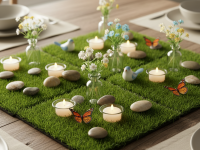Hey there, fellow wood whisperers and creative spirits! Have you ever found yourself completely engrossed in a carving project, shaping beautiful lines and bringing your vision to life, only to have your hands start screaming for a break? That burning sensation, the cramping fingers, the nagging ache in your wrist… it’s a familiar foe for many of us who love to shape wood, isn’t it?
For years, I just accepted hand fatigue as an inevitable part of the wood carving journey. I’d push through the discomfort, shake out my hands, and keep going, often at the expense of my own comfort and, let’s be honest, the quality of my work as fatigue set in. But then, I discovered the world of ergonomic wood carving tools, and let me tell you, it was a game-changer. It wasn’t just about a “nicer” handle; it was about reclaiming my passion, extending my carving sessions, and enjoying the process without the constant battle against pain.
In this article, I want to share my experience and insights into why ergonomic handle wood carving tools are not just a luxury, but a necessity, especially if you’re serious about your craft and your long-term hand health. Let’s dive in!
Why Hand Fatigue Isn’t Just an Aoyance – It’s a Threat to Your Passion
We pour our hearts into our carving. Each cut, each detail, is a testament to our dedication. But when hand fatigue sets in, it does more than just make you uncomfortable. It can:
- Halt Your Creativity: It’s hard to stay in the flow when your hands are protesting. Ideas get cut short, and intricate details become daunting.
- Impact Your Accuracy and Safety: Tired hands are less steady hands. This can lead to slips, mistakes, and even injuries – something no carver wants.
- Lead to Long-Term Health Issues: Persistent strain can contribute to conditions like carpal tuel syndrome, tendonitis, and repetitive strain injuries. Trust me, these are things you want to avoid!
- Diminish Your Enjoyment: If carving becomes a painful chore, you’ll find yourself doing it less and less, eventually losing touch with a hobby you once loved.
I know this firsthand. There were times I’d abandon a project mid-way, not because I was out of ideas, but because my hands simply couldn’t take it anymore. It was frustrating, demoralizing, and frankly, uecessary once I realized there was a better way.
What Exactly Makes a Carving Handle “Ergonomic”?
So, what’s the magic behind an ergonomic handle? It’s not rocket science, but it is thoughtful design rooted in understanding human anatomy and biomechanics. An ergonomic handle is designed to:
- Distribute Pressure Evenly: Instead of concentrating pressure on a few points, it spreads it across the palm, reducing hot spots and discomfort.
- Promote a Neutral Wrist Position: This is crucial. A neutral wrist (straight, not bent up or down, or side to side) reduces strain on tendons and nerves.
- Provide a Secure, Non-Slip Grip: Good grip means less squeezing, which means less muscle fatigue.
- Match Your Hand Size: A handle that’s too small forces an uatural pinch grip; one too large can be hard to control. Ergonomic designs often come in varying sizes or have shapes that accommodate different hands.
- Be Made from Comfortable Materials: Wood, composite, or rubberized materials that feel good in the hand, absorb some vibration, and aren’t overly slick or abrasive.
Think about it: traditional carving handles are often straight, round, and relatively thin. While iconic, they often force your hand into a vice-like grip to maintain control, which is the perfect recipe for fatigue.
My Personal Revelation: The Switch to Ergonomic Carving Tools
For years, I carved with standard, straight-handled tools. They were what I learned with, and I didn’t know any different. My hands would ache after an hour or two, and my wrist would often throb. I even developed a mild tingling sensation in my fingers after particularly long sessions.
A few years ago, a friend in a carving club noticed my discomfort and suggested I try one of his tools – it had a handle shaped like a rounded tear-drop, much fuller in the palm. I was skeptical, but I gave it a try. The difference was immediate and astonishing. My hand felt relaxed, not clenched. The pressure was distributed so beautifully across my palm. I could carve for twice as long without that familiar burning ache.
That day was a turning point. I started researching and investing in ergonomic tools. It wasn’t an overnight switch for my entire collection, but slowly, as I replaced or added tools, I prioritized ergonomic designs. And honestly? My carving has never been better. I’m more productive, more precise, and most importantly, I enjoy every single minute of it without the distraction of pain.
Beyond the Basic Grip: Key Features to Look For
When you’re shopping for ergonomic carving tools, here are some specific features to keep an eye out for:
- Palm Swells: These are the most common ergonomic feature. The handle is thicker in the middle, filling your palm and allowing for a more relaxed grip. Think of a comfortable door handle, not a thin dowel.
- Contoured Shapes: Some handles are specifically shaped to fit the natural curves of a human hand, often with subtle finger grooves or an oval cross-section that prevents the handle from rotating accidentally.
- Offset Handles: For some tools, especially gouges or V-tools, an offset handle can keep your wrist straighter while allowing the tool’s cutting edge to be at the optimal angle to the wood.
- Rubberized or Textured Grips: These materials enhance grip without requiring you to squeeze harder. They also often provide a bit of vibration dampening.
- Weight and Balance: A well-balanced tool, where the weight feels right in your hand and the center of gravity is conducive to control, is inherently more ergonomic.
- Interchangeable Handles: Some brands offer blades that can be swapped into different handle styles, allowing you to customize your grip for various tasks or simply choose the one that feels best.
Don’t be afraid to hold the tool in your hand before buying, if possible. Wiggle it, simulate carving motions. How does it feel? Does it encourage a relaxed grip or a tight squeeze?
Not Just Handles: Ergonomic Tools for Every Carving Need
While we often think of knives first, ergonomic design applies to a wide range of wood carving tools:
- Carving Knives: From detail knives to general purpose knives, many now come with ergonomic handles that promote comfort and control.
- Gouges and Chisels: These are often the biggest culprits for hand fatigue. Ergonomic handles on gouges can make a huge difference, especially with the repeated pushing motions.
- Power Carving Tools: Even rotary tools and reciprocating carvers have ergonomic considerations, from vibration reduction to grip design. While the primary focus here is hand tools, it’s worth noting the principle applies broadly.
- Mallets: A well-balanced mallet with a comfortable grip can also reduce fatigue when working with chisels and gouges.
The key is to consider how each tool interacts with your hand and whether its design actively works to minimize strain.
It’s Not Just the Tool: Holistic Approaches to Hand Health
While ergonomic tools are fantastic, they’re part of a bigger picture when it comes to preventing hand fatigue and maintaining your carving health. Here are a few other tips I’ve picked up along the way:
- Take Regular Breaks: This is huge. Set a timer for every 30-45 minutes and step away. Stretch your hands, fingers, and wrists. Get a drink of water. Look away from your work.
- Maintain Sharp Tools: A dull tool requires more force to cut, which puts immense strain on your hands and wrists. Keep your tools razor-sharp – it’s safer and far less fatiguing.
- Vary Your Grip and Stance: Don’t always hold the tool the exact same way. Shift your grip slightly, change your body position. This distributes the work among different muscles.
- Improve Your Posture: A hunched back or strained neck can indirectly affect hand fatigue. Ensure your workbench height is appropriate and you’re sitting or standing comfortably.
- Do Hand and Wrist Exercises: Simple stretches and strengthening exercises can significantly improve your hand endurance and flexibility.
- Listen to Your Body: This is probably the most important. If something hurts, stop! Don’t push through pain. Your body is telling you something.
Making the Investment: Why Ergonomic Tools Are Worth Every Pey
Let’s be honest, ergonomic tools can sometimes come with a slightly higher price tag than their traditional counterparts. But consider it an investment – an investment in your health, your comfort, and your ability to pursue your passion for years to come. For me, the cost was negligible compared to the discomfort and potential health issues I was avoiding.
When you’re comfortable, you’re more focused, more creative, and more likely to produce your best work. You’ll carve for longer sessions, enjoy the process more deeply, and reduce the risk of debilitating injuries that could take you away from your workbench entirely.
My advice? Start small if you need to. Replace your most frequently used carving knife or gouge with an ergonomic option. Feel the difference for yourself. I’m confident that once you experience the comfort and improved control, you’ll wonder how you ever carved without them.
So, go ahead, treat your hands with the respect they deserve. Your body and your beautiful carvings will thank you for it!



